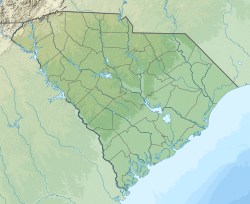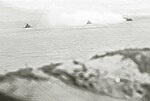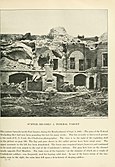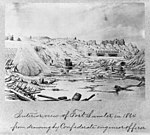Fort Sumter
Fort Sumter | |
IUCN Category V (Protected Landscape/Seascape) | |
 | |
| Location | Charleston Harbor, Charleston, South Carolina |
|---|---|
| Coordinates | 32°45′8″N 79°52′29″W / 32.75222°N 79.87472°W |
| Area | 234.74 acres (95.00 ha)[2] |
| Built | 1829 |
| Visitation | 857,883 |
| Website | Fort Sumter and Fort Moultrie National Historical Park |
| NRHP reference No. | 66000101[1] |
| Significant dates | |
| Added to NRHP | October 15, 1966 |
| Designated HD | April 28, 1948 |
Fort Sumter is a
The building of Fort Sumter
Named after American military officer Thomas Sumter, Fort Sumter was built after British forces captured and occupied Washington during the War of 1812 via a naval attack. It was built near Charleston, South Carolina as one of the third system of U.S. fortifications to protect American harbors from a naval invasion. Constructed on an artificial island in the middle of the channel that provides Charleston with natural shelter, Fort Sumter was intended to dominate the harbor, reinforcing the protection provided by the shore artillery batteries at Fort Moultrie, Fort Wagner, and Fort Gregg.
The artificial island was originally a
The brick fort is five-sided, 170 to 190 feet (52 to 58 m) long, with walls five feet (1.5 m) thick, standing 50 feet (15.2 m) over the low tide mark. Although never completed, it was designed to house 650 men and 135 guns in three tiers of gun emplacements.
Construction dragged out because of title problems, then problems with funding such a large and technically challenging project. Unpleasant weather and disease made it worse. The exterior was finished but the interior and armaments were never completed.[4][5]: 104–105

Ownership
Early in the nineteenth century, South Carolina had owned multiple forts, namely Fort Moultrie, Castle Pinckney, and Fort Johnson, but ceded them, along with sites for the future erection of forts, to the United States in 1805.[6]: 2 The forts were of questionable military value and costly to maintain, so when asked to cede them, the state complied.[5]: 103 This was not the last time that South Carolina would cede forts to the United States; on December 17, 1836, South Carolina officially ceded all "right, title and, claim" to the site of Fort Sumter to the United States.[6]: 4
Civil War
Summary

Fort Sumter is notable for two battles, the first of which began the American Civil War. It was one of a number of special forts planned after the War of 1812, combining high walls and heavy masonry, and classified as Third System, as a grade of structural integrity. Work started in 1829, but was incomplete by 1861, when the Civil War began.
The attack on Fort Sumter is generally taken as the beginning of the American Civil War—the first shots fired. Certainly it was so taken at the time—citizens of Charleston were celebrating. The First Battle of Fort Sumter began on April 12, 1861, when South Carolina Militia artillery fired from shore on the Union garrison. These were, both sides agreed, the first shots of the war. The bombardment continued all day, watched by many happy civilians. The fort had been cut off from its supply line and surrendered the next day. Major Robert Anderson took the flag with him as they evacuated.
The Second Battle of Fort Sumter (September 8, 1863) was a failed attempt by the Union to retake the fort, dogged by a rivalry between army and navy commanders. Although the fort was reduced to rubble, it remained in Confederate hands until it was evacuated as General Sherman marched through South Carolina in February 1865.
A widely announced
Preparing for war
On December 26, 1860, only six days after
In a letter delivered January 31, 1861,
After realizing that Anderson's command would run out of food by April 15, 1861,
First Battle of Fort Sumter

On Thursday, April 11, 1861, Beauregard sent three aides, Colonel
On Friday, April 12, 1861, at 4:30 a.m., Confederate
-
[Top] A photographic view of the Hot shot Furnace at right shoulder angle and a 10-in. columbard cannon pointing to Charleston;[16][Bottom] Exterior view of Gorge and Sally Port Ft Sumter April 1861 after its surrender
-
Views of Ft Sumter; [Bottom] View of right angle
-
Right angle gorge of Ft Sumter-Sally port at right
-
View of the Gorge and Sally Port
-
View of western part of Gorge
-
[Top] View of gorge and Sally port; [Bottom] Left gorge Angle
-
View of Left gorge angle Sally Port would be at far left
-
View of Left flank
-
Panormanic View of Left shoulder Angle at left with a 2nd Hot Shot furnace and Left face at right; Ft Sumter 1861; flying theConfederate Flag
-
At Left North west casemates [left angle]; at right can be seen the start of the right angle
The Fort Sumter Flag became a popular patriotic symbol after Major Anderson returned North with it. The flag is still displayed in the fort's museum. The Star of the West took all the garrison members to New York City. There they were welcomed and honored with a parade on Broadway.
Union siege of Fort Sumter

Union efforts to retake Charleston Harbor began on April 7, 1863, when
The Confederates, in the meantime, were strengthening Fort Sumter. A workforce of just under 500 enslaved Africans, under the supervision of Confederate army engineers, were filling
A special military decoration, known as the Gillmore Medal, was later issued to all Union service members who had performed duty at Fort Sumter under the command of Major-General Quincy Adams Gillmore.
| Location | Armament |
|---|---|
| Left flank barbette | Two 10-inch (250 mm) columbiads |
| Left face barbette | Two 10-inch (250 mm) columbiads, two 8-inch (200 mm) columbiads, four 42-pounders |
| Left face, first tier casemates | Two 8-inch (200 mm) shell guns |
| Right face barbette | Two 10-inch (250 mm) columbiads, five rifled and banded 42-pounders |
| Right face, first tier casemates | Two 32-pounders |
| Right flank barbette | One XI-inch Dahlgren (From USS Keokuk), four 10-inch (250 mm) columbiads, one 8-inch (200 mm) Columbiad, one rifled 42-pounder, one 8-inch (200 mm) Brooke |
| Gorge barbette | Five rifled and banded 42-pounders, one 24-pounder |
| Salient, second tier casemates | Three rifled and banded 42-pounders |
| Parade | Two 10-inch (250 mm) seacoast mortars |
-
East Face of Ft Sumter 1863
-
View of Confederate-held Fort Sumter, August 23, 1863
-
George Cook, half stereo of Federal ironclads firing on Fort Moultrie, September 8, 1863 (click to enlarge) – The Valentine, Richmond, Va.
-
Lt. John R. Key's (CSA) "exploding shell" painting, of the interior of Fort Sumter – The Valentine, Richmond, Va.
-
The first breach after the bombardment of September 8, 1863
-
C.S. Cook picture of Ft Sumter after the bombardment September 28,1863 showing the "Hot shot" Furnace at left and the Barracks at right
-
Interior View of Fort Sumter
-
The Flag of Sumter, October 20, 1863
-
Ft Sumter from the west angle December 9, 1863
-
Ft Sumter View of entrance to Three Gun Bat'y December 9, 1863
-
1864 sketch of bombardment of Ft Sumter
-
Interior View of Fort Sumter, taken by a Confederate photographer, 1864 [1863]
-
Interior View of Fort Sumter, taken by a Confederate photographer
-
Interior View of Fort Sumter, taken by a Confederate photographer, 1864.
-
Interior View of Fort Sumter 1864
-
Interior View of Fort Sumter 1864
-
Interior View of Fort Sumter 1864
-
Interior View of Fort Sumter December 9, 1864
-
Exterior view of Fort Sumter, 1865. Banded rifle in the foreground, fraise at the top.
-
Exterior view of damage to Fort Sumter,
-
View of Fort Sumter from the sandbar, 1865.
-
View of Battery Johnson with Ft Sumter in the background
-
Interior of Ft Sumter
-
Interior of Ft Sumter 1865
-
Interior of Ft Sumter 1865 showing the Hot Shot Furnace.
-
Interior view of Ft Sumter in 1865; at left is the "Light house" of Ft Sumter
After the devastating bombardment, both Major General
The

After the unsuccessful boat assault, the bombardment recommenced and proceeded with the varying degree of intensity, doing more damage to Fort Sumter until the end of the
Recovery of Fort Sumter
The last Confederate commander, Major Thomas A. Huguenin, a graduate of
Anderson, now a major general, returned to Sumter with the flag he had been forced to lower four years earlier, and on April 14, 1865, raised it in triumph over the ruined fort. Henry Ward Beecher was present and subsequently spoke at length about the occasion.
After the war

When the Civil War ended, Fort Sumter was in ruins. The U.S. Army worked to restore it as a useful military installation. The damaged walls were re-leveled to a lower height and partially rebuilt. The third tier of gun emplacements was removed. Eleven of the original first-tier gun rooms were restored with 100-pounder Parrott rifles.
From 1876 to 1897, Fort Sumter was used only as an unmanned lighthouse station. The start of the
One hundred and forty-seven years after it was sent, a rolled up telegraphic message was found in a trunk belonging to Col. Alexander Ramsay Thompson of New York and eventually given to a museum in Charleston, S.C. The telegram was dated April 14, 1861 from the Governor of South Carolina to Gazaway Bugg Lamar in New York, reading in part:[21]
Fort Sumter surrendered yesterday after we had set all on fire... F.W. Pickens
In 1966, the site was listed on the
Fort Sumter and Fort Moultrie National Historical Park
Fort Sumter and Fort Moultrie National Historical Park encompasses three sites in Charleston: the original Fort Sumter, the Fort Sumter Visitor Education Center, and Fort Moultrie on Sullivan's Island. Access to Fort Sumter itself is by a 30-minute ferry ride from the Fort Sumter Visitor Education Center or Patriots Point. Access by private boat is no longer allowed.[24]
The Visitor Education Center's museum features exhibits about the disagreements between the North and South that led to the incidents at Fort Sumter. The museum at Fort Sumter focuses on the activities at the fort, including its construction and role during the Civil War.
April 12, 2011, marked the 150th Anniversary of the start of the Civil War. There was a commemoration of the events by thousands of Civil War reenactors with encampments in the area. A United States stamp of Fort Sumter and a
On June 28, 2015, in the aftermath of the events of June 17, 2015, when a
By December 2019, sea level rise led to a Park Service decision to move some of the large rocks "originally installed to protect the fort from the sea," farther from the fort's walls, in order to create a protective breakwater and wetland.[26]
-
Fort Sumter National Monument
-
Aerial view of Fort Sumter National Monument
-
The interior of Fort Sumter from the top of the fort
-
Tourists at Fort Sumter on a summer afternoon
-
Cannon displayed at Fort Sumter
See also
Notes
- ^ a b "National Register Information System". National Register of Historic Places. National Park Service. July 9, 2010.
- ^ "Listing of acreage – December 31, 2011" (XLSX). Land Resource Division, National Park Service. Retrieved May 14, 2012. (National Park Service Acreage Reports)
- ^ "Fort Sumter National Monument – Draft General Management Plan Environmental Assessment" (PDF). National Park Service. 1998. p. 10. Retrieved July 30, 2015.
- A&E Television Networks (History Channel). December 11, 2019 [November 9, 2009]. Retrieved December 20, 2020.
- ^ ISBN 978-0-15-600741-2.
- ^ OCLC 1591687.
- newspapers.com.
- ^ a b c d e f [full citation needed]
- ^ Robert Anderson to Rev. R. B. Duane, December 30, 1860
- ^ Robert Anderson to Robert N. Gourdin, December 27, 1860.
- ^ Haskin, William, Major, 1st U.S. Artillery (1896). "History of the 1st U.S. Artillery". Archived from the original on July 25, 2010.
{{cite web}}: CS1 maint: multiple names: authors list (link) CS1 maint: numeric names: authors list (link) - ISBN 978-1-62376-744-0.
- ^ Harris, W.A. (1862). The record of Fort Sumter, from its occupation by Major Anderson, to its reduction by South Carolina troops during the administration of Governor Pickens. Columbia, SC: South Carolinian Steam Job Printing Office. p. 7. Retrieved September 27, 2014.
- ^ Official Records of the Union and Confederate Navies Series I – Volume 4. pp. 223–225.
- ^ (Detzer 2001, pp. 269–271).
- ^ See Ft Sumter Map "Battles and Leaders of the Civil War Vol 1 p. 54
- ^ Traverses, Civil War Fortifications dictionary.
- ^ Civil War Dictionary
- ^ Civil War Dictionary
- ^ a b "Fort Sumter National Monument, Charleston County (Charleston Harbor and Sullivan's Island)". National Register Properties in South Carolina. South Carolina Department of Archives and History. Retrieved June 11, 2012.
- ^ A telegram comes home – Post and Courier, Charleston, South Carolina
- ^ Nelson, Benjamin G. (October 10, 1973). "Fort Sumter National Monument" (PDF). National Register of Historic Places – Nomination and Inventory. Retrieved June 11, 2012.
- ^ [1] American Battlefield Trust "Saved Land" webpage. Accessed May 24, 2018.
- ^ "Feds block private boats, drop-in visits to historic Fort Sumter in Charleston Harbor". The Post And Courier. Retrieved April 2, 2021.
- ^ "Timeline Photos – Fort Sumter National Monument". Facebook. Archived from the original on February 26, 2022.
- ^ Manuzak, Stephanie (December 12, 2019). "Fort Sumter contends with sea-level rise and extreme storms". Yale Climate Connections. Retrieved December 19, 2019.
References
- Allen, Kevin. "The Second Battle of Fort Sumter: The Debate over the Politics of Race and Historical Memory at the Opening of America's Civil War Centennial, 1961." The Public Historian (2011) 33#2 pp. 94–109 in JSTOR
- ISBN 978-1-4341-0322-2.
- Cooper, William J.We Have the War Upon Us: The Onset of the Civil War, November 1860–April 1861 (2012)
- Detzer, David R. (2001). Allegiance: Fort Sumter, Charleston and the Beginning of the Civil War. New York: Harcourt. ISBN 0-15-100641-5.
- ISBN 978-0-598-97210-1.
- Hatcher, Richard (2024). THUNDER IN THE HARBOR: Fort Sumter and the Civil War. Myrtle Beach, SC: Savas Beatie. ISBN 978-1-61121-593-9.
- Hendrix, M. Patrick. A History of Fort Sumter: Building a Civil War Landmark (The History Press, 2014)
- Ripley, Warren (1984), Artillery and Ammunition of the Civil War, Charleston, S.C.: The Battery Press, ISBN 0-88394-003-5
- Silkenat, David. Raising the White Flag: How Surrender Defined the American Civil War. Chapel Hill: University of North Carolina Press, 2019. ISBN 978-1-4696-4972-6.
- Wise, Stephen R. (1994). Gate of Hell: Campaign for Charleston Harbor, 1863. Columbia: University of South Carolina Press. ISBN 0-87249-985-5.
Primary sources
- Elliott, Stephen Jr. (1902). "Detailed report, September 12, 1863". Official Records of the Union and Confederate Navies in the War of the Rebellion, Series I. 14. Washington, D.C.: Government Printing Office: 637–639.[failed verification]
- Scott, Robert N. (1890). "Return of Casualties in the Confederate forces at Fort Sumter, August 12 – December 11 (1863)". The War of the Rebellion: A Compilation of the Official Records of the Union and Confederate Armies, Series I. XXVIII (Part I). Washington, D.C.: Government Printing Office: 650. Archived from the original on February 9, 2008. Retrieved November 18, 2007.
- Stevens, Thomas H.. (1902). "Delayed report, September 28, 1865". Official Records of the Union and Confederate Navies in the War of the Rebellion, Series I. 14. Washington, D.C.: Government Printing Office: 633. Retrieved November 18, 2007.[failed verification]
- Turner, John W. (1890). "Reports". The War of the Rebellion: A Compilation of the Official Records of the Union and Confederate Armies, Series I. XXVIII (Part I). Washington, D.C.: Government Printing Office: 212–225. Archived from the original on February 9, 2008. Retrieved November 18, 2007.
External links
- Tulane University multimedia teaching tool on Fort Sumter
- Library of Congress collection of photos of Fort Sumter
- National Park Service's official website for Fort Sumter
- Specialized sites
- Charleston, SC Insider's Guide Archived February 11, 2007, at the Wayback Machine
- The Civil War Field Fortifications Website Archived October 15, 2007, at the Wayback Machine
- Historic Charleston's Religious and Community Buildings, a National Park Service Discover Our Shared Heritage Travel Itinerary Archived July 26, 2008, at the Wayback Machine



![[Top] A photographic view of the Hot shot Furnace at right shoulder angle and a 10-in. columbard cannon pointing to Charleston;[16][Bottom] Exterior view of Gorge and Sally Port Ft Sumter April 1861 after its surrender](http://upload.wikimedia.org/wikipedia/commons/thumb/5/5d/The_Photographic_History_of_The_Civil_War_Volume_09_Page_046.jpg/118px-The_Photographic_History_of_The_Civil_War_Volume_09_Page_046.jpg)
![Views of Ft Sumter; [Bottom] View of right angle](http://upload.wikimedia.org/wikipedia/commons/thumb/6/61/The_Photographic_History_of_The_Civil_War_Volume_09_Page_045.jpg/118px-The_Photographic_History_of_The_Civil_War_Volume_09_Page_045.jpg)



![[Top] View of gorge and Sally port; [Bottom] Left gorge Angle](http://upload.wikimedia.org/wikipedia/commons/thumb/e/e5/The_Photographic_History_of_The_Civil_War_Volume_09_Page_048.jpg/118px-The_Photographic_History_of_The_Civil_War_Volume_09_Page_048.jpg)



![At Left North west casemates [left angle]; at right can be seen the start of the right angle](http://upload.wikimedia.org/wikipedia/commons/thumb/c/c1/Salient_with_North-west_Casemates%2C_Fort_Sumter_MET_DP266616.jpg/150px-Salient_with_North-west_Casemates%2C_Fort_Sumter_MET_DP266616.jpg)











![Interior View of Fort Sumter, taken by a Confederate photographer, 1864 [1863]](http://upload.wikimedia.org/wikipedia/commons/thumb/0/03/Interior_view_of_Fort_Sumter%2C_Charleston%2C_S.C._taken_by_a_Confederate_photographer_in_1864_%28i.e._1863%29_LCCN2013651649.jpg/150px-Interior_view_of_Fort_Sumter%2C_Charleston%2C_S.C._taken_by_a_Confederate_photographer_in_1864_%28i.e._1863%29_LCCN2013651649.jpg)




















